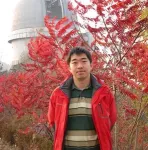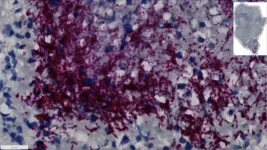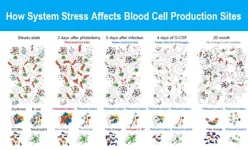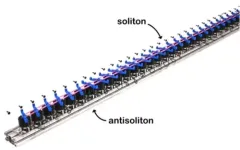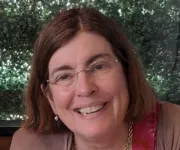(Press-News.org) NEW YORK, NY — Motor neurons are the cells the brain uses to command muscles to act. Scientists typically thought of them as simple connections, much like the cables that link computers with their accessories. Now, in fly studies, researchers at Columbia's Zuckerman Institute have discovered that single motor neurons can each direct an insect’s body to move in far more complex ways than previously thought.
The findings were published in Nature on March 20.
"This is one of the first times scientists have analyzed in 3D what single motor neurons do while the body moves naturally," said Stephen Huston, Ph.D., an associate research scientist at Columbia’s Zuckerman Institute, and the study’s corresponding author. "You can't understand how the brain makes the body move without knowing what each motor neuron does, just as you can't understand how a puppeteer makes a marionette move without understanding what the puppet strings do."
Motor neurons are the final links through which the brain controls the body's motions, from a flick of a finger to a blink of an eye. Despite this pivotal duty, researchers are only now beginning to uncover the role that single motor neurons play in movement. Measuring the activity of individual neurons in moving animals has proven to be experimentally difficult.
Now advances in laboratory techniques have made it possible for researchers to manipulate single motor neurons in fruit flies as the insects move freely.
In experiments that began at the Howard Hughes Medical Institute’s Janelia Research Campus in Ashburn, Virginia, the first step for the researchers was to activate light-sensitive molecules in the 25 or so motor neurons that control head movements of the sesame-seed-sized fly. This enabled the scientists to use red light to switch on motor neurons one at a time. At the same time, they recorded the resulting head motions while using artificial intelligence techniques to track these movements.
"Most neurons act in concert as a population, so we didn't expect to see much or even any head movement at all when we activated just one motor neuron at a time," Dr. Huston said.
At most, the scientists had expected that each single motor neuron was hardwired to produce one simple motion — for instance, making the head turn left 10 degrees. Instead, through computational analysis later performed at the Zuckerman Institute, the researchers discovered that activating each motor neuron could make the head rotate in a variety of ways, some even in opposite directions from each other, depending on the starting posture of a fly's head.
"I was really excited about how specifically we could activate individual neurons to drive these motions," said Benjamin Gorko, a Ph.D. student in the molecular, cellular, and developmental biology department at the University of California, Santa Barbara, and the study's first author.
The scientists liken this kind of motor control to a digital thermostat, where punching in a desired temperature will cause a room to warm up or cool down depending on the current room temperature. In much the same way, when the researchers stimulated each motor neuron, the fly's head moved towards a pose specific to that motor neuron, with the insect's head rotating one way or the other to reach that desired position depending on its starting posture.
The research team's thermostat-like model suggests that when the brain wants to move the body a specific way, it cannot simply stimulate the same set of motor neurons each time and expect the same result. Instead, the brain must calculate which motor neurons to activate based on sensory data it receives about the body's current posture. Indeed, deactivating sensory neurons that monitor the fly's head position altered how the insect moved when the scientists stimulated the motor neurons.
Pinpointing what the brain does on the cellular level in fruit flies is more than just an academic exercise. "A better understanding of what motor neurons do can help us understand diseases that affect the motor system, such as amyotrophic lateral sclerosis, also known as ALS or Lou Gehrig’s disease," Dr. Huston said.
Next the researchers want to investigate how other kinds of neurons in the fly, such as those in the visual system, interact with motor neurons to control movement.
###
The paper, "Motor neurons generate pose-targeted movements via proprioceptive sculpting," was published online in Nature on March 20, 2024.
The full list of authors includes Benjamin Gorko, Igor Siwanowicz, Kari Close, Christina Christoforou, Karen L. Hibbard, Mayank Kabra, Allen Lee, Jin Yong Park, Si Ying Li, Alex B. Chen, Shigehiro Namiki, Chenghao Chen, John C. Tuthill, Davi D. Bock, Hervé Rouault, Kristin Branson, Gudrun Ihrke and Stephen J. Huston.
The authors report no conflicts of interest.
END
Modern humans dispersed from Africa multiple times, but the event that led to global expansion occurred less than 100,000 years ago. Some researchers hypothesize that dispersals were restricted to “green corridors” formed during humid intervals when food was abundant and human populations expanded in lockstep with their environments. But a new study in Nature, including ASU researchers Curtis Marean, Christopher Campisano, and Jayde Hirniak, suggests that humans also may have dispersed during arid intervals along “blue highways” created by seasonal rivers. Researchers also found evidence of cooking and stone tools that represent the oldest evidence of archery.
Working ...
Researchers at Fred Hutchinson Cancer Center have found that a specific subtype of a microbe commonly found in the mouth is able to travel to the gut and grow within colorectal cancer tumors. This microbe is also a culprit for driving cancer progression and leads to poorer patient outcomes after cancer treatment.
The findings, published March 20 in the journal Nature, could help improve therapeutic approaches and early screening methods for colorectal cancer, which is the second most common cause of cancer deaths in adults in the U.S. according to the American Cancer Society.
Examining colorectal cancer tumors removed from ...
Some anti-cancer treatments not only target tumour cells but also healthy cells. If their effects on the latter are too strong, their use can become limiting. A team from the University of Geneva (UNIGE), in collaboration with Basel-based FoRx Therapeutics, has identified the mechanism of action of PARP inhibitors, used in particular for breast and ovarian cancer in patients carrying the BRCA gene mutation. These inhibitors block two specific activities of the PARP proteins. By blocking one of them, the toxic effect on cancer cells is maintained, while healthy cells are preserved. This work, published in the journal Nature, will help improve the efficacy of these treatments.
Despite ...
Imagine being able to count the different types of blood cells being formed inside the tiny bones of a mouse and pinpointing the strings and clusters of cells within the bone marrow that are responsible for producing specific types of blood cells.
That’s exactly what a team of scientists led by experts at Cincinnati Children’s achieved in a far-reaching study published March 20, 2024, in the prestigious journal Nature. Their work adds unprecedented new understanding of the “elegant” and “resilient” anatomy of bone marrow while also generating evidence of unexpected variations in how the skeleton ...
HOUSTON ― The University of Texas MD Anderson Cancer Center’s Research Highlights showcases the latest breakthroughs in cancer care, research and prevention. These advances are made possible through seamless collaboration between MD Anderson’s world-leading clinicians and scientists, bringing discoveries from the lab to the clinic and back.
Recent developments at MD Anderson offer insights into a combination therapy that slows pancreatic cancer progression, an all-oral treatment for older patients with acute myeloid leukemia (AML) unable to receive intensive chemotherapy, novel targets to protect against osteoporosis and bone metastasis, the generation ...
If it walks like a particle, and talks like a particle… it may still not be a particle. A topological soliton is a special type of wave or dislocation which behaves like a particle: it can move around but cannot spread out and disappear like you would expect from, say, a ripple on the surface of a pond. In a new study published in Nature, researchers from the University of Amsterdam demonstrate the atypical behaviour of topological solitons in a robotic metamaterial, something which in the future may be used to control how robots move, sense their surroundings and communicate.
Topological solitons can be found in many ...
The Advanced Research Projects Agency for Health (ARPA-H) has appointed Etta D. Pisano, MD, FACR, senior portfolio lead, to build the agency's clinical trial portfolio and lead the ARPA-H Advancing Clinical Trials Readiness Initiative under ARPA-H Resilient Systems Mission Office Director Jennifer Roberts.
The first radiologist to be appointed to such a role, Dr. Pisano is an internationally recognized expert in women's health, breast cancer research, and the use of artificial intelligence in ...
Scientists have for the first time created a giant quantum vortex to mimic a black hole in superfluid helium that has allowed them to see in greater detail how analogue black holes behave and interact with their surroundings.
Research led by the University of Nottingham, in collaboration with King’s College London and Newcastle University, have created a novel experimental platform: a quantum tornado. They have created a giant swirling vortex within superfluid helium that is chilled to the lowest possible temperatures. Through the observation of minute wave dynamics on the superfluid’s surface, the research team has shown that these quantum ...
Researchers have developed FloorLocator, a breakthrough in indoor navigation technology, which combines the high efficiency of Spiking Neural Networks (SNNs) with the advanced learning capabilities of Graph Neural Networks (GNNs). This innovative approach ensures remarkable accuracy and scalability for floor localization, crucial for enhancing emergency responses, indoor positioning, and personalized recommendation systems.
Indoor positioning is transforming with applications demanding precise location tracking. Traditional methods, including fingerprinting and sensor-based techniques, though widely used, face significant drawbacks such as the ...
The bustling streets of a modern city are filled with countless individuals using their smartphones for streaming videos, sending messages and browsing the web. In the era of rapidly expanding 5G networks and the omnipresence of mobile devices, the management of cellular traffic has become increasingly complex. To address this challenge, mobile network operators need methods for the accurate prediction of cellular traffic. A comprehensive survey published 5 Jan. in Intelligent Computing explores deep learning techniques for cellular traffic prediction.
Better cellular traffic prediction would enhance intelligent 5G network construction and resource management, thereby ...

